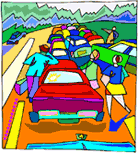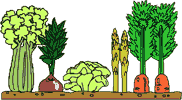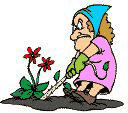
How gardening can weed out
diabetes
Share this with your friends and family
By Marion Owen, Fearless Weeder
for PlanTea, Inc. and
Co-author of Chicken Soup for the Gardener's Soul
FEATURE ARTICLE:

Tom Hanks' "Power of Four" solution
More good stuff:
Who is Marion Owen?
FAQs about PlanTea
Search Marion's articles, tips and recipes
Why grow organic?
News and press releases
Read love letters
How to link to this site
Need a speaker?
How to contact Marion
Visiting Alaska?
Come to Kodiak Island!
Go to home page

Marion's UpBeet Gardener
Newsletter has been
replaced by Marion's blog
which you can find at:
www.marionowen.wordpress.com
Dear gardeners, moms, politicians and neighbors,
The facts are sobering. According to the Associated Press, one in three US children born in 2000 will be a diabetic. The Center for Disease Control (CDC) warns that at this rate, by 2025, the number of people with diabetes in the world will go up from 140 million to 300 million.
The CDC also reports that, more than 18 million Americans have diabetes. Now the 6th leading cause of death in America, diabetes is responsible for over 200,000 deaths each year. The number of US adults with diagnosed diabetes has increased 61 percent since 1991 and is projected to more than double by 2050. That's why it's so important to educate the public about diabetes and focus on preventing it from developing in the first place.

In this article we'll learn how gardening, diet and exercise can be solutions to the problem. First, you may be wondering...
What is diabetes and are you at risk?
People with diabetes have a shortage of insulin or a decreased ability to use insulin, a hormone that allows glucose (sugar) to enter cells and be converted to energy. When diabetes is not controlled, glucose and fats remain in the blood and, over time, damage vital organs. Diabetes can cause heart disease, stroke, blindness, kidney failure, pregnancy complications, lower-extremity amputations, and deaths related to flu and pneumonia. Particularly at risk for these complications are the 5.2 million Americans who are unaware that they have diabetes.
Helpful links:
- Center for Disease Control (CDC)
- American Diabetes Association
- Diabetes UK
- Canadian Diabetes Association
- Children With Diabetes Association
The two types of diabetes
Type 1 most often appears during childhood or adolescence. Type 2 diabetes, which is linked to obesity and physical inactivity, accounts for about 90 percent of diabetes cases and most often appears among people older than 40. However, it is no longer considered an adult-only disease. Type 2 is now being found at younger ages and is even being diagnosed among children and teens.
|
“New
evidence shows that one in three Americans born in 2000 will develop
diabetes sometime during their lifetime. Together we can and must
do more to prevent and control this growing epidemic of diabetes.”
|
Diabetes has its greatest effects on the elderly, women, and certain racial
and ethnic groups. One in five adults over age 65 has diabetes. African
American, Hispanic, American Indian, and Alaska Native adults are two
to three times more likely than white adults to have diabetes.
Can you have diabetes, sort of?
Yes, in addition to the millions of Americans with diabetes, an estimated 16 million US adults aged 40 to 74 have pre-diabetes. That is, their blood sugar level is elevated but is not high enough to be classified as diabetes. People with prediabetes are at high risk for developing diabetes.
Gardening can help in many ways
How does gardening tie in? First of all, gardening and yard work is an excellent form of exercise, building strength and muscle mass. As a weight-bearing exercise, gardening not only burns calories, it is good for the bones, too. Listen up ladies, we have another tool against osteoporosis.

Yes, studies show that exercise and diet can dramatically reduce the
development  of type 2 diabetes in those at risk for the disease. As for
people who have the disease, "It was once thought that people with
diabetes could not withstand vigorous physical exercise. This is no longer
believed to be true," says Stanley Gershoff, Ph.D. and author of
The Tufts University Guide to Total Nutrition. "Indeed, exercise
ranks as one of the most effective ways of normalizing high blood sugar
levels."
of type 2 diabetes in those at risk for the disease. As for
people who have the disease, "It was once thought that people with
diabetes could not withstand vigorous physical exercise. This is no longer
believed to be true," says Stanley Gershoff, Ph.D. and author of
The Tufts University Guide to Total Nutrition. "Indeed, exercise
ranks as one of the most effective ways of normalizing high blood sugar
levels."
To properly deal with vigorous exercise, says Gershoff, is to carefully time exercise, meals and insulin doses, or for less vigorous exercise, such as gardening and for those with diabetes who are not on insulin, regular exercise does not have to be timed as carefully.
How healthy is your food?
Do you know what's really IN your food?
As to food and diet, many experts blame the increased love of fast foods for the rise in obesity and diabetes. But we all have choices. You don't need to be a rocket scientist to know that the fewer processed foods we consume, the healthier our diet will be.
|
"You can't buy soil quality in a bag any more than you can buy good nutrition in a pill. -- Charles Benbrook, Ph.D. |

Fresh foods, such as fruits and vegetables, are better for you than canned and processed ones. My neighbor tells me that the closer you eat to the source (where food is actually grown), the healthier the food. She's right. You can't argue the fact that apples, berries, onions and lettuce grown or harvested in your own neighborhood are nutritionally superior than foodstuffs that traveled 1,000 miles to get to your table. One other important fact: According to the US Department of Agriculture's National Nutrient Database, nutrients in conventionally-grown vegetables and fruits are declining.
The Shopper's Guide to Pesticides in Produce The Environmental Working Group (EWG), has compiled the data into a handy, wallet-sized guide called The Shopper's Guide to Pesticides in Produce. Download a free copy from the EWG's Food News website. For more information, read the article: "What's in Your Food? The most and least contaminated fruits and vegetables" |
Now the amazing clincher: You can grow more of your own food and you and your
family will be healthier for it. (In addition to enjoying better food, there are many reasons to grow your own, including saving money!). Remember, healthy food begins with healthy
soil. Learn what grows well in your area. Incorporate organic gardening methods. Learn about compost, weeding without chemicals, soil pH, and the best ways to use manure and kelp in the garden.
Here in Kodiak, Alaska, we have several nurseries and garden centers. One day, I stopped by to chat with one of the owners. She told me she spends a lot of time talking with her customers about dirt. "My biggest challenge is soil education. To help people succeed in gardening, they need to understand what makes healthy soil."
And healthy soil means healthy plants, which means a healthier diet. Yes, you can do it!

NOTE: This article is not meant to be the end-all about diabetes. For more information, please conduct further research and contact your health provider. Thank you.
![]()
Thanks for visiting and please stop by again. I'll put the coffee on!
Meet Marion Owen /// Learn about PlanTea /// Online Catalog /// Articles, Tips, Recipes /// Get free UpBeet Gardener newsletter /// Read current issue /// Listen to radio show /// Read news and press releases /// More resources and links /// Learn why 'grow organic?' /// View guidelines for retailers /// Read love letters /// Book Marion as a speaker /// Site map /// How to link to us /// Contact us /// Go to home page
PlanTea: The organic plant food in tea bags. http://www.plantea.com
Copyright ©1996 to present: PlanTea, Inc. All Rights Reserved. PO Box 1980, Kodiak, AK 99615-1980 USA
Questions or comments? marion@plantea.com Phone: Toll Free: 1-800-253-6331 (US and Canada); 907-486-2500